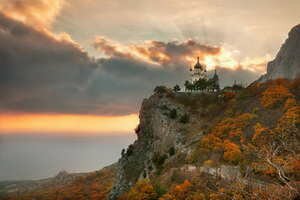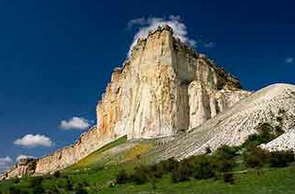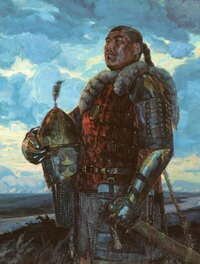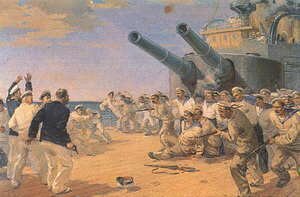
Oleh Makhno
Proclaiming not so long ago the Crimean autonomy, its most ardent supporters, apparently, could not, in general, predict some of the consequences of the process. At least the consequences that we see today in the Peninsula or until recently at the blocked by activists its “main entrance”. So who is interested in such “autonomy”? Among the answers to this question you will hear: “native population”. The population, which, this way or other, now is said to consist of Russians and the Crimean Tatars. And who else, apart from those mentioned, have reasons to consider themselves indigenous people, due to having lived there the longest and having succeeded most in cultivating and culturalizing the Crimean Peninsula? Remember that on its southern coast there have been found a lot of tools that are more than eight hundred thousand years old. They could only belong to Pithecanthropes - people of the ancient Stone Age. 250-35 thousand years ago Neanderthalers lived here, and 35-8 thousand years ago - Cro-Magnon men did... Archaeologists have discovered 15 settlements of primitive people in the Crimea. The oldest one is in the cave Kiik-Koba where they found a burial of a women and a year old child…
 White Rock in Crimea, where it was discovered Neanderthal settlement |
The Crimea was inhabited by people in more recent times of the Mesolithic and Neolithic, Copper and Bronze Ages. That is, people have constantly lived in the Crimea. Many modern scholars believe that these people were those ancient Ukrainians, who formed the basis of our civilization.
However, the Russian historiography - both, the Tsarist and the Soviet one (by the way, as well as the German one) - had always denied the modern Ukrainians' connection with the ancient eras' population of the Black Sea. Because Ukrainians allegedly appeared on the scene not earlier than in the 15th-16th centuries. Accordingly, everything that had been in Ukraine before that has nothing to do with Ukrainians. In particular, the so-called “Greek colonization of the Northern Black Sea”, “Scythians-Iranians” and so on. Although it is known that the Greek shopping areas were built in the Ukrainian Black Sea coastal cities only with the permission of their real owners. For example, scientists believe that the territory of Olbia had been a Scythian settlement long before Greeks. As for the “Iranian” Scythians, once Professor Petrov aptly commented that they were neither Iranians not Turans (Turks), but Ukrainians. The founder of the modern Ukrainian historiography Professor Volodymyr Antonovych also pointed out that Slavic tribes originated from Scythians. And the “Soviet” Academician Marr agreed with this theory, which for political reasons was denied by anti-Ukrainian propaganda.
|
Державні утворення на півострові Таврика (з середини XVIст. також Крим, Crimea) напередодні турецького вторгнення 1475 року 1 – Територія князівства Феодоро; 2 – факторії Генуезької республіки;3 – володіння роду Гіреїв |
So, from time immemorial, the most famous states of the Northern Black Sea coast had been ancient Ukrainian states. All those tribes called Scythians, Sarmatians, Geths and others had been pro-Ukrainian tribes. The fact that they were not called as they are today is not surprising. After all, today Ukrainians call the Deutsch “Germans”, that is “mute”. Some of the European nations in the past were called and are now called “Alemans”, “Germans”, “Francs”, “Tadesks”, “Goths” and so on. And so we have our historical and contemporary names.
Despite the Crimea's having repeatedly been subject to attacks of strangers, the indigenous Ukrainian population has survived all enemy attacks and managed to preserve the thread of the Ukrainian culture in the old land of Taurida, the land of the “Tauri” - one of the pro-Ukrainian tribes. The Crimean Mountains have Boyko ridge - those who know about the Boykivshchyna etnoregion in Lviv region, do understand what the toponym means. The well-known “cave” cities of the Crimea by their rocky architecture are similar to Tustan fortress in the Carpathian Mountains. The ancient astronomical observatory on the southern coast of the Crimea has an analogy in Chornohora. A custom of Scythian burial mounds had been observed by Ukrainian Cossacks and soldiers of newer Ukrainian armed formations. Currently, we have also honored the fallen heroes in the same way ...
Speaking about the Tatars, the first mention of their stay in the Crimea dates back to 1222. It was then that in the steppes of the Northern Black Sea there appeared a twenty thousand Mongol troops' corps under the command of Sabutai and Chepe sent by Genghis Khan on a long road to the West for the “deep intelligence” of the European theater of the Horde's forthcoming hostilities.
According to Ukrainian historian Dmytro Doroshenko, “…In 1222-1223 Tatars wintered in our steppes and took a diversion to the Crimea, where they devastated Surozh (Sudak).” Accordingly, in Surozh Synaxarion in which in the 12th-13th centuries chronological comments were recorded, under the date of January 27, 1223 there is a record: “On this day, for the first time the Tatars came, in 6731”.
May 30, 1223 in the Battle of the Kalka River (now Kalmius - D. Doroshenko) the Tatars faced the combined forces of Ukrainian princes. “The Princely troops and rural regiments fought bravely, but were defeated,” says D. Doroshenko. Then the Tartars disappeared. The chronicler pointed out that the terrible enemy “came out of nowhere, and disappeared into destination unknown”. They returned in 1239 and destroyed Pereyaslav, Chernihiv, and in 1240 - Kyiv. As a result, the Ukrainian state lost its South for a long time, and its local population lost its defense.
Thus, the original inhabitants of the Crimean Peninsula were beaten and robbed by strangers; Ukrainian princes tried to somehow protect the local population and fight back the nomads from the East.
What happened then? According to the researcher Mykola Melnyk, “In 1239, the Tatars seized the Eastern Crimea, which became an ulus (province) of the Golden Horde, and in 1298 - 1299 the Tartars captured the Western Crimea”. This is something that concerns the Steppe Crimea alone.
As for the Southern Coast, in the middle of the 13th century, in some coastal cities there settled Venetians (in 1287 Surozh was led by the Consul sent from Venice), and later - the Genoese. The main commercial and political center of the Genoese was Kafa (Feodosia).
Since the first half of the 15th century historical sources had also been mentioning the orthodox Christian principality Theodoro with the same-name center in the mountainous Crimea (on the current Mangup Mountain).
At the beginning of the 15th century, thanks to the military assistance of the Lithuanian-Ukrainian state, the steppe Crimean ulus of the Golden Horde was ruled by Giray dynasty. They also founded the Perekop (Crimean) Khanate.
So, by the middle of the 15th century in the Crimea coexisted several state and administrative entities: Orthodox, Catholic and Muslim ones. None of them covered the whole territory of the Peninsula. But the balance of power was short-lived. In 1475, the Turks turned up in the Crimea. They captured the Genoese colonies of the Southern Crimea. The Tatars recognized the authority of the Turkish Sultan and together with his troops destroyed the orthodox principality of Theodoro. Since then, the Crimea had become Turkey's sphere of influence.

Public formation on the Crimean peninsula in the middle of the XV century
|
Former Theodoro and Genoese territories, with mainly Christian population, had become an integral part of the Ottoman Empire - Kafa Sandzak and later the Eyalet, which lasted until 1774. This administrative division, subject to Istanbul, had never been a part of the Crimean Khanate.
The Turkish official Evliya Çelebi (1611-circa 1683), who in 1666-1667 conducted a census of the Crimea, got some interesting data on the ethnic composition of the Crimean Khanate. According to the records, the Muslim population was 187,000 people, of whom 87,000 belonged to the military stratum (Askeri Tiifesi). Ukrainians counted for 920,000. Evliya divides them into three groups: 1) subjects (esir) - 600,000; 2) slaves: women and girls (Difki) - 120,000; 3) children – 200,000.
That is, in the 1666-1667 years, 4/5 of the population of the Crimea were Ukrainians. Evliya writes on this subject: “Therefore, if - save us Allah from that - so many infidels and disobedient Cossacks (Ukrainians) rebelled, they would put the entire Crimean Peninsula upside down ...” (Evlija Gelebi. Siyahatnameni (Istanbul: Turk Tarih Kalliyati 1928), t.8. - P.33-35).
By the way, the number of Rayah that is, Jews, Karaites, Armenians and Greeks in the Crimea, according to Evliya, was 20,000 people (Record in the “Ukrainian Studies”. Reader. - K., 1996. - Lybid. - P.350-351). While the Russians (Muscovites) are not mentioned, as there were no Russians in the Crimea at the time.
There were no Russians in other Khan's dominions either. Thus, Zaporizhzhyan translator Andriy Konstantinov, in his report on the visit to Khan's Ukraine (Southern Podillya and the area between the Bug and the Dniester), wrote: “Nowhere did I find Russian subjects in the Tatar settlement, which were inhabited by Wallachians, Armenians, Polish Ukrainians and Jews”. (A. Andriyivskyi, Materials on the History of Zaporizhzhya. “Notes of the Odessa Community - hist. and ancient”. V. XVII, 1894, pp. 94-96).
Apart from the ports of the Crimea, the Turks settled in the Ukrainian ports of the Northern Black Sea fortresses, in particular, in the ones locking the mouths of Ukrainian rivers: Dashiv (Ochakov) on the Dnieper River, Chernohorod near the later Ackermann, Khachibeiv (Khadjibey, Odessa), Azov and others. So, the ancient route “from the Vikings to the Greeks” and the whole Ukraine's Black Sea trade got under Turkey's control. But it was not the bread from Ukrainian fields that provided the greatest profit to Bakhchysarai and Istanbul, but the trade of slaves from Ukraine. They were provided to the markets of the Ottoman Empire by the Crimean Khanate.
Having freed themselves from dependence on Golden Horde with the help of Cossacks' troops under the command of Lithuanian Gediminas, the Crimean Giray dynasty quickly began the rapprochement with Turkey (1475). And soon they had another ally - Moscow.
Modern Ukrainian researcher V. Bilinskyi, having analyzed the works of Russian historians, in particular, Karamzin's and B. Klyuchevskiy's, states that in 1480, Moscow recognized itself the Crimean Khan's vassal in exchange for military aid against the Golden Horde and the Grand Duchy of Lithuania, which included the majority of Ukrainian lands.
 Mengli Giray |
May 14, 1482, into the Crimea from Moscow was sent Mikhail Kutuzov's Embassy, which delivered generous “remembrances” (gifts) to Mengli Giray and his nobles which were supposed to help achieve the desired for Moscow results in the negotiations. Through his Ambassadors, Ivan III was asking Mengli Giray to immediately start military actions against the Grand Duchy of Lithuania, having determined specific targets (located outside of Lithuania) for the attack. Ambassadors had to ask the Khan, “... to send his army into Podillya land and into Kyiv's territories”. What forced the Prince of Moscow to persuade the Crimean Khan to attack Ukraine?
The matter is that in the second half of the 15th century, due to the strengthening of the Catholic-Orthodox opposition in the higher circles of the Grand Duchy of Lithuania, among the Ukrainian princes, nobles and common people had increased dissatisfaction with the rule of the princes from the Gediminas dynasty. The logical way out of the difficult for Ukrainians situation could be termination of confederal ties with Lithuania and restoration of the independent state of Kyiv. But such a development of events in Ukraine did not meet in the first place, the Kremlin's plans, which provided for the “liberation” and “reunification” of Ukraine with the same faith Muscovy. Moscow's authorities were also concerned with the appointing in 1481 in Lithuania's Novgorodka of Metropolitan of Kyiv and all Rus’ Simeon. The fear of renewed Ukrainian state with secular and ecclesiastical capital of Kyiv had caused Moscow's very active diplomacy in the Crimea in spring of 1482. Thanks to its efforts, the Crimean Tatar troops in late August - early September 1482 attacked Kyiv's territories. And Kyiv was burned completely. There survived only some (badly damaged by the attackers) monumental structures dating to the times of the Ancient Kyiv State - St. Sophia and St. Michael's Cathedrals, Kyiv-Pechersk and Vydubychi Monasteries, St. Cyril's Church and the Golden Gate.
But the most significant losses were suffered by the population of the city and the suburbs. Mengli Giray captured them; he captured even Kyiv's governor and his family. The fate of the governor was shared the Pechersk Abbot; the monastery itself was looted; running away from the attackers, some monks “fled into the cave and died from lack of air”.
The Nikon Chronicle tells us that “September 1, according to the word of the Great Prince of all Rus’, Ivan Vasylyovych, Khan of the Crimean Perekop Horde Mengli Giray came, with all his forces to the King's state, and burnt off the city of Kyiv, and captured the Governor of Kyiv Ivashko Hotkovych, and captured innumerable people; and emptied Kyiv's land”. “Having captured 11 Rus' border cities” up to Zhytomyr, Mengli Giray smoothly returned to the Crimea.
The 1485's destruction of the city of Kyiv had disastrous consequences. The growing development of Kyiv of the times of the Olelkoviches was interrupted for a long time. The revival of the Ukrainian state, the heir to the traditions of the state of Kievan Rus’, was delayed by nearly 200 years (1648). But that's not all. According to D. Doroshenko, the pogrom was only a prelude for further, even more destructive pogroms. In 1485 Podillya was devastated, in 1488 - Kyiv region, in 1490 - Volyn and Kholmshchyna, and then almost every year there were devastating attacks. Achievements of culture and civilization of two centuries were destroyed within a few years, the whole Ukraine along the rivers Ros and Desna was turned into a desert. Hundreds of thousands of local people were enslaved by Tatars. In the Ukrainian steppes began the era of the slave trade, which can only be compared with that in Africa much later in history.
During Khmelnytskyi's times (1648-1681), the Tatars for more than 30 years were present in Ukraine as the Cossacks' army' s ally against Poland, or as Poland's ally against Moscow-Ukrainian Union after the signing of the Pereyaslav Treaty, and later - as an ally of Hetmans of anti-Moscow orientation. This can be explained by the fact that in the interests of both Tatars and Turks was the weakening of Poland, and at the same time preventing the independence of Ukraine. Therefore Cossacks kept being betrayed in crucial moments of the war (Battle of Zboriv, Berestechko and Zhvanets).
In the second half of the 17th century, the Crimean Khanate took part in the division of Ukraine between the neighboring countries. This is evidenced by the so-called “Khan's” Ukraine, covering the southern Podillya and the territory between the rivers Bug and Dniester, led by Khan's hetmans such as Ivan Drahynych, Stetsyk, Petro Ivanenko (Petryk) and Ivan Bahatyi. They were the Ukrainian population's representatives before Turkish and Tatar authorities and the governments of neighboring states. Residences of Khan's Hetmans were in Yagorlyk, and later - in Dubossary on the Dniester, where they were until 1770s.
The Crimean Khanate's geopolitical game to undermine the power of the Ukrainian people and its state did not bring good luck to the Tatars. In 1783, when the Russians were destroying the remnants of Ukrainian Hetmanate, Russian Empress Catherine II announced annexation of the Crimean Khanate by Russia.
 The uprising on the battleship "Potemkin" |
According to official Russian statistics, in 1913, the population of the Crimea was 729 thousand people. Tatars accounted for 20 % of the population (in Yevpatoriya 21.1 % and 22.5 % - in Perekop). Ukrainians and Russians accounted for 53 % (379,000). Based on the fact that the Ukrainians were recorded as “Russians”, Professor S. Rudnytskyi stated: “The bulk of the ethnographic mosaic of the Crimea now, without a doubt, is Ukrainian. In 1914 the number of Ukrainians was estimated at 65 %, Great Russians making no more than 12 % (see S. Rudnytskyi, Fundamentals of Land Studies of Ukraine, pp. 215, 235).
At the end of the 19th and the beginning of the 20th centuries, Ukrainians were the majority on trading ships and ships of the Black Sea Fleet. Names of warships in tsarist times were mainly Ukrainian, for example, “Gaydamak”, “Zaporozhets”, “Ukraine”, “Kuban”. During the first Russian revolution of 1905, the ships with Ukrainian staff opposed the Tsar, having drowned in the sea Moscow's officers. The uprising on the armored battleship “Potyomkin” was led by Ukrainians Vakulenchuk and Matiushenko, the ship's Chief Engineer was Kovalenko.
To be continued…

